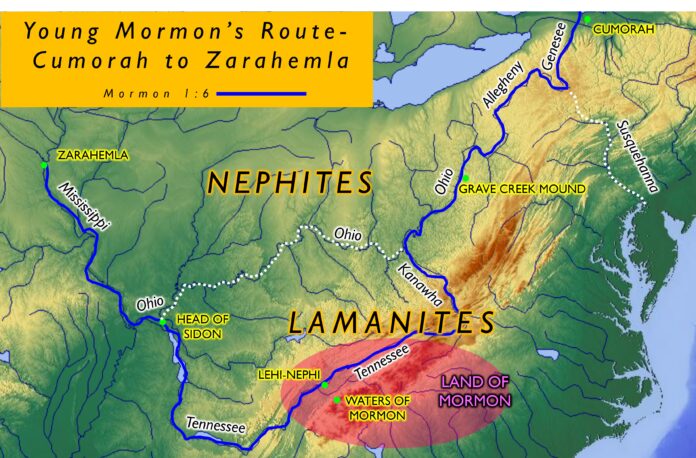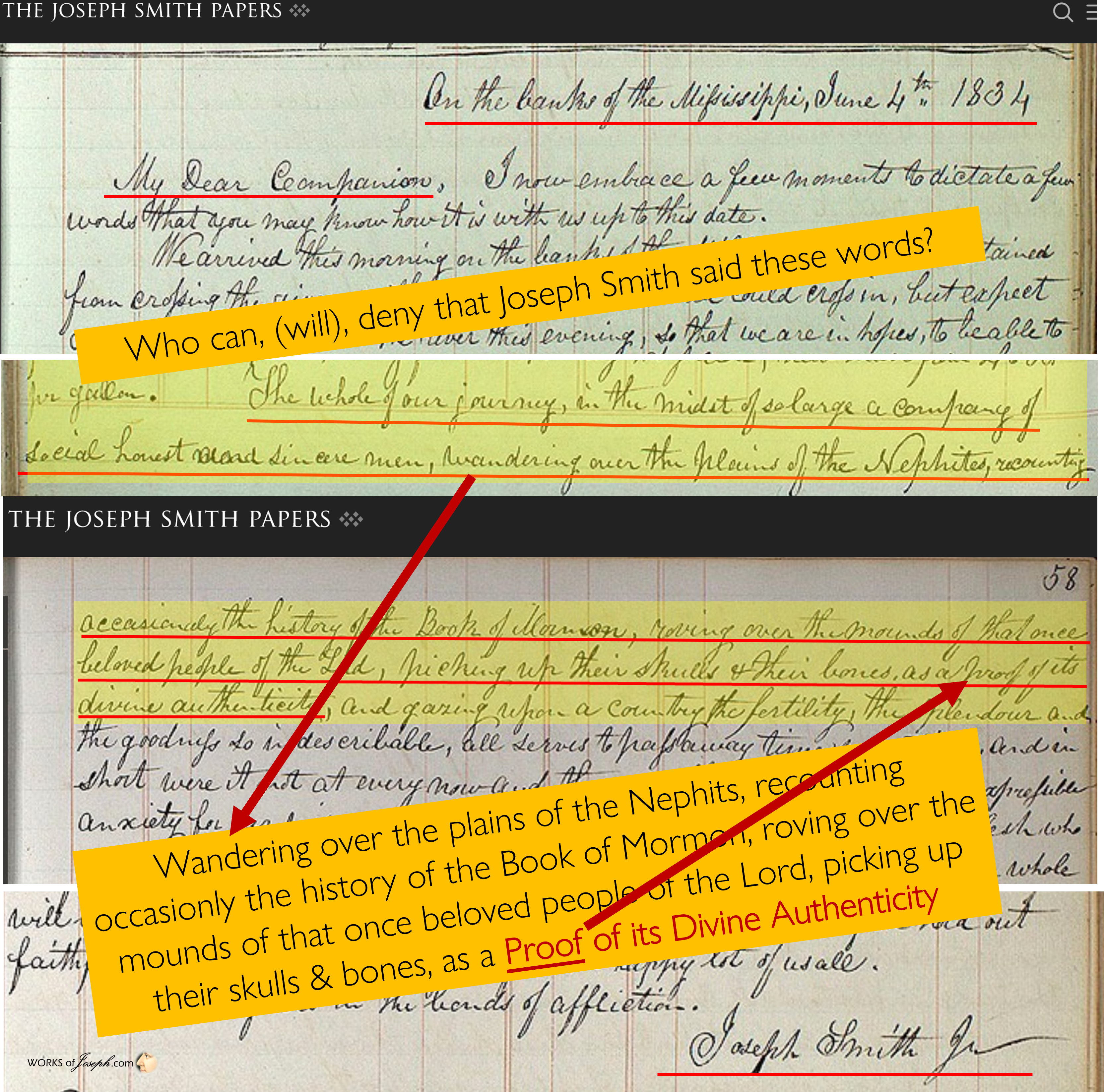Young Mormon at age 11, “was carried” or transported by boat, by his father Mormon, as they traveled most likely from Cumorah on the Allegheny/Ohio River through Moundsville, WV, through eastern Tennessee, Kentucky and then to Missouri and then to the Land of Zarahemla. “And it came to pass that I, being eleven years old, was carried by my father into the land southward, even to the land of Zarahemla. The whole face of the land had become covered with buildings, and the people were as numerous almost, as it were the sand of the sea.” Mormon 1:6-7.

MORMON, “CARRIED BY MY FATHER… TO THE LAND OF ZARAHEMLA.” MORMON 1:6
The name Mormon represents a great man and a great name by which we are known today as Latter-day Saints. “Such was the goodness, the strength, the power, the faith, the prophetic heart of the prophet-leader Mormon. He was the chief compiler of the book which is called after his name and which has come forth in this period of the world’s history as a voice speaking from the dust in testimony of the Lord Jesus Christ. All of this places upon us of this Church and this generation an incumbent and demanding responsibility to recognize that as we are spoken of as Mormons, we must so live that our example will enhance the perception that Mormon can mean in a very real way, “more good.” Mormon Should Mean “More Good” Gordon B. Hinckley Oct 1990.
Land of Mormon

“Mormon abridged the entire record of the descendants of Lehi. How did he learn so much about his country? Mormon’s book begins with him at age ten. He writes, “I began to be learned somewhat after the manner of the learning of my people and Ammaron said unto me: I perceive that thou art a sober child, and art quick to observe. Mormon 1:2.” Moroni’s America by Jonathan Neville page 239.
The origin of the name Mormon in the Book of Mormon, is interesting. “Now it was the custom of the people of Nephi to call their lands, and their cities, and their villages, yea, even all their small villages, after the name of him who first possessed them” Alma 8:7. Apparently a great leader named Mormon was in the land of Nephi before the time of Alma, for there was a place called the Waters of Mormon, and the Place of Mormon. Mosiah 18:7-8. Mormon, while abridging the Book of Mormon says, “And behold, I am called Mormon, being called after the Land of Mormon, [Tennessee and Northern Georgia?], the land in which Alma did establish the church among this people: Yea, the first church which was established among them after their transgression.” 3 Nephi 5:12. Alma’s baptizing seems to be the first time in a few generations that covenants were established again among the Nephites. The name Mormon seems to have reminded the people of the restoration of the covenants and the establishment of Christ’s church at the Place of Mormon in 148 BC or earlier. Latter-day Saints associate with the name of the Book of Mormon as did the Nephites of old, with the restoring of covenants among the people. Also the 1986 addition to the Book of Mormon added a subtitle, “Another Testament of Jesus Christ,” which reinforces these covenants.
In Mormon 1:3-5, Ammaron gives Mormon further instructions regarding his role as a record keeper. Jonathan Neville in his book Moroni’s America writes; “The text gives no information about the location of the “land Antum,” but it does mention “the hill of Shim” [Map Below] in Ether 9:3. In that verse, Omer passes by the hill after he is overthrown. Later, the way Moroni (who abridged Ether) refers to the hill suggests he was familiar with it… Certainly Moroni knew the place where the Nephites were destroyed.
Hill Shim
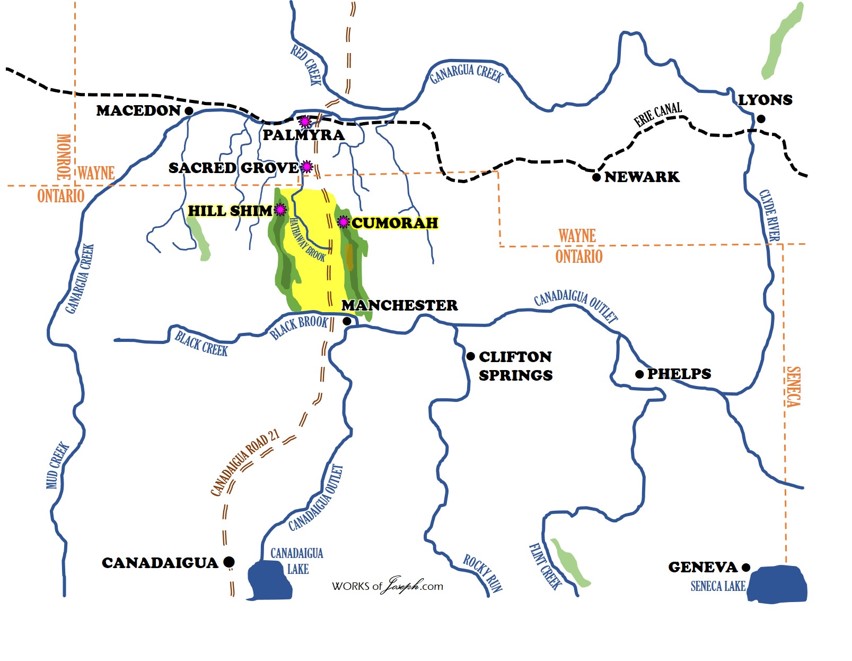 According to Oliver Cowdery and Joseph Smith, this was the valley west of the Hill Cumorah in New York, just south of Palmyra. Moroni refers to “the hill of Shim” specifically. Since he had Mormon’s record and knew all about the hill Cumorah and the plates, I infer Moroni identified the hill of Shim by name so his readers would make the connection. In other words, the hill Shim was in western New York, somewhere in proximity to the hill Cumorah. That would put the land Antum in the general area, which means Ammaron was in that area when he hid the records. Ammaron didn’t have to explain to young Mormon where the land Antum was; I infer from this that as a boy, Mormon lived not too far away from Antum. Later, when he reaches the age of 24, Mormon will do as Ammaron told him (See Mormon 2:17-18), and get the plates of Nephi. Later he will remove all the plates from the hill Shim (Mormon 4:23) to keep them from the Lamanites. But first, Mormon needs to learn about his country. The text doesn’t say why he did it, but Mormon’s father takes his son on a long field trip. I think the father was present when Ammaron told the ten-year-old boy what his calling would be and took it upon himself to educate his son. Mormon 1:6 “And it came to pass that I, being eleven years old, was carried by my father into the land southward, even to the land of Zarahemla.” Mormon’s father waited only about a year before taking his son on the trip. He “carried” the boy, a term that suggests a mode of conveyance. Surely Mormon the father didn’t carry his eleven-year-old son in his arms or on his shoulders. I think the most likely conveyance was a boat, like a canoe. Maybe it was just Mormon and his father, or maybe the entire family went on the journey.” Moroni’s America Page 240
According to Oliver Cowdery and Joseph Smith, this was the valley west of the Hill Cumorah in New York, just south of Palmyra. Moroni refers to “the hill of Shim” specifically. Since he had Mormon’s record and knew all about the hill Cumorah and the plates, I infer Moroni identified the hill of Shim by name so his readers would make the connection. In other words, the hill Shim was in western New York, somewhere in proximity to the hill Cumorah. That would put the land Antum in the general area, which means Ammaron was in that area when he hid the records. Ammaron didn’t have to explain to young Mormon where the land Antum was; I infer from this that as a boy, Mormon lived not too far away from Antum. Later, when he reaches the age of 24, Mormon will do as Ammaron told him (See Mormon 2:17-18), and get the plates of Nephi. Later he will remove all the plates from the hill Shim (Mormon 4:23) to keep them from the Lamanites. But first, Mormon needs to learn about his country. The text doesn’t say why he did it, but Mormon’s father takes his son on a long field trip. I think the father was present when Ammaron told the ten-year-old boy what his calling would be and took it upon himself to educate his son. Mormon 1:6 “And it came to pass that I, being eleven years old, was carried by my father into the land southward, even to the land of Zarahemla.” Mormon’s father waited only about a year before taking his son on the trip. He “carried” the boy, a term that suggests a mode of conveyance. Surely Mormon the father didn’t carry his eleven-year-old son in his arms or on his shoulders. I think the most likely conveyance was a boat, like a canoe. Maybe it was just Mormon and his father, or maybe the entire family went on the journey.” Moroni’s America Page 240
“Carried” by Canoe?
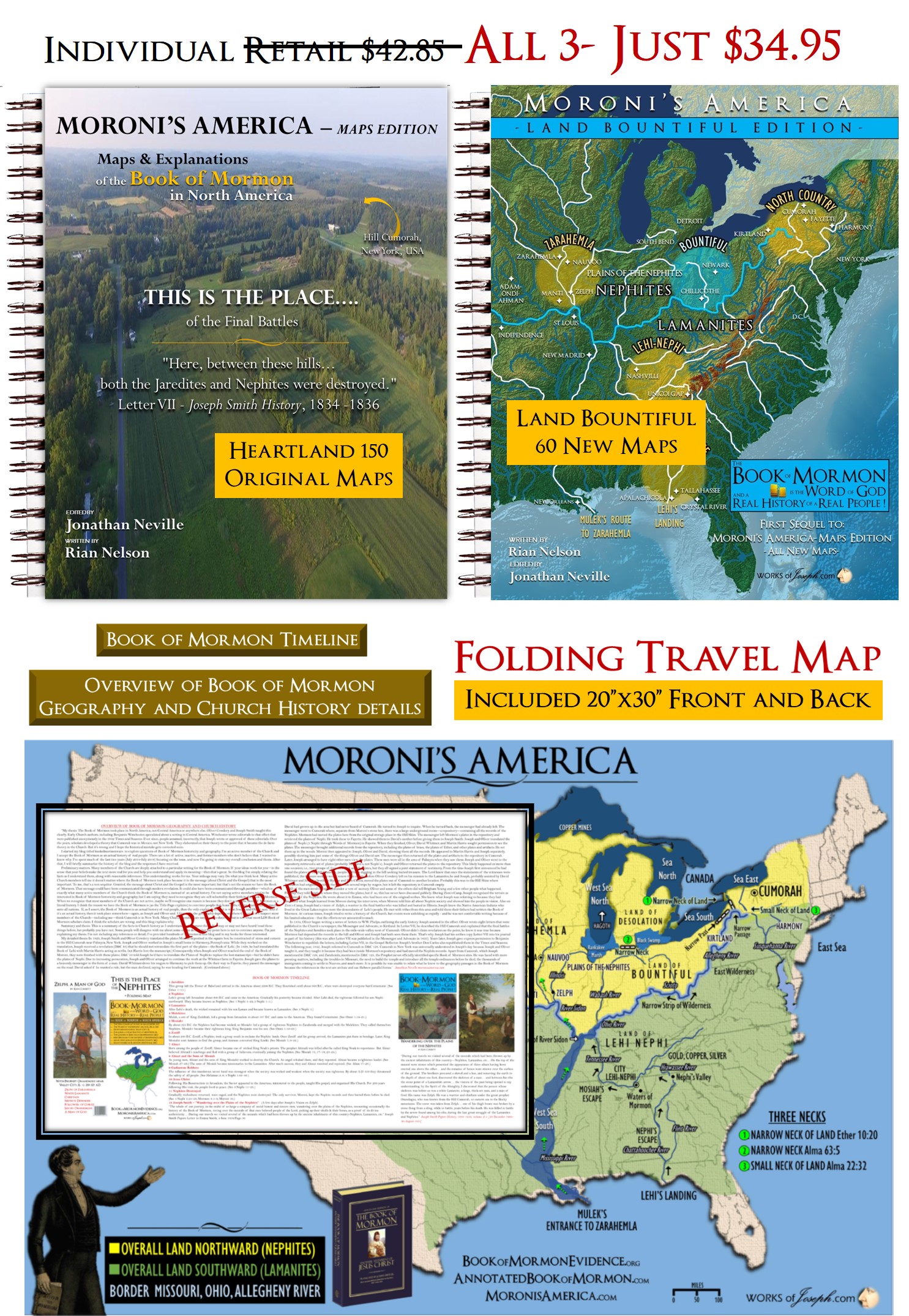
“Canoes were developed over the course of thousands of years by the native peoples of North America. The word ‘canoe’ originated from the word ‘kenu’ – meaning dugout. North American Indians are responsible for creating the more well-known version of the canoe – a frame of wooden ribs covered with the lightweight bark of birch trees, and sometimes elm or cedar trees. These boats, which have remained virtually unchanged in design for thousands of years, proved to be ideal for travelling the numerous streams, rivers and lakes of North America. Birch bark was the perfect choice to build canoes because, not only was it lightweight and smooth, but it was also waterproof and resilient. The joints of the canoes were held together by the root of the white pine and then made waterproof by applying hot pine or spruce resin… Many of the canoes that fur traders used were capable of carrying a crew of up to 12 people and a cargo weighing around 2400 kilograms… At a typical length of 14 ft. and weight of 50 lbs., the canoes were light enough to be portaged, yet could carry a lot of cargo, even in shallow water. Although susceptible to damage from rocks, they are easily repaired.” Bark Canoes Canadian Museum of Civilization.
During this journey by canoe it is very likely that young Mormon would have kept a type of journal probably on parchment or papyrus. This way he could recall what to write at age 24 when Ammaron had commanded him to keep a record. It also seems likely that even though this was a time of peace, older Mormon would have brought with him the Sword of Laban and breastplate and others would have their armor, head plates, and weapons nearby. They may have even used the Liahona, or other devices for physical and spiritual guidance.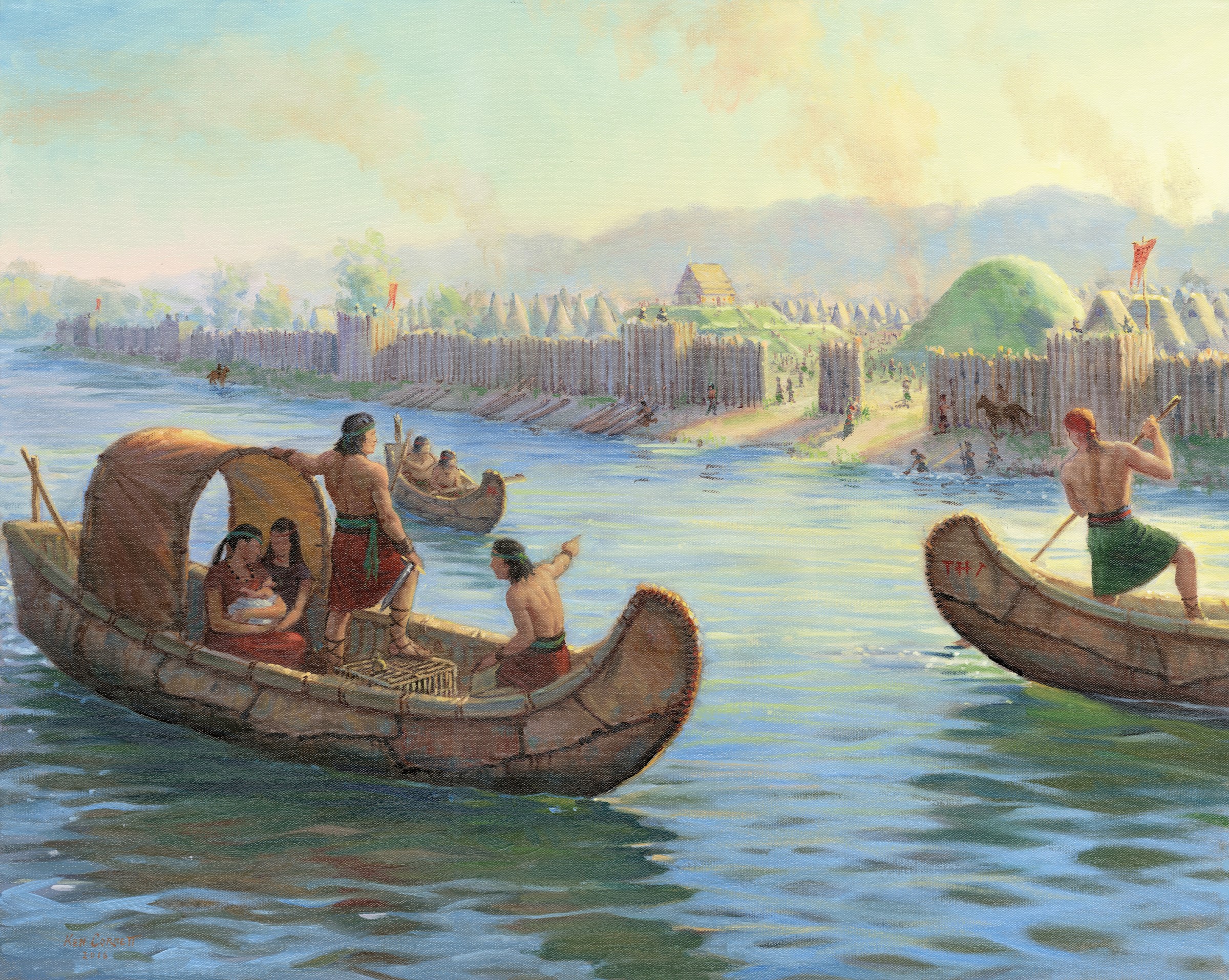
This painting by Ken Corbett, represents Mormon with his son, Mormon traveling south on the Ohio River heading towards the Land Zarahemla in Illinois and Missouri. Near Grave Creek Mound in West Virginia, you can visualize in Mormon 1:6-7 it saying, “And it came to pass that I, being eleven years old, was carried by my father into the land southward, even to the land of Zarahemla. The whole face of the land had become covered with buildings, and the people were as numerous almost, as it were the sand of the sea.” Young Mormon is pointing to the Grave Creek mound and all the buildings around.
Zarahemla Land Southward and Land Northward?
“Mormon refers to the land of Zarahemla as “the land southward.” What is his frame of reference? Many times in the text, Mormon refers to Zarahemla as the land northward. For example, he explained that “Now the land south was called Lehi, and the land north was called Mulek, which was after the son of Zedekiah; for the Lord did bring Mulek into the land north, and Lehi into the land south” (Helaman 6:10). But here, he refers to Zarahemla as “the land southward.”
Obviously he is writing from a reference point north of Zarahemla… Starting from the northern area near the land Antum, Mormon and his father would travel south to reach the Allegheny River, then south to join the Ohio River, then south along the Ohio River until it moves more westerly. Only once he reaches the head of Sidon would he turn north. Mormon wouldn’t be looking at Google Earth or a map of the globe to determine the relative latitude of his destination (although, even technically, Zarahemla is south of his starting point). Mormon would refer to the direction they headed; i.e., they went “into the land southward” from the perspective of someone leaving from the Cumorah area. Later, Mormon will write about how the Lamanites drove the Nephites northward, back to the area of his homeland. During his field trip, the boy Mormon was amazed at what he saw. “The whole face of the land had become covered with buildings, and the people were as numerous almost, as it were the sand of the sea.” Mormon 1:7. The whole face of the land would be the areas through which Mormon traveled. Imagine what it would be like for a young boy to leave his homeland and “see the world” with his parents.
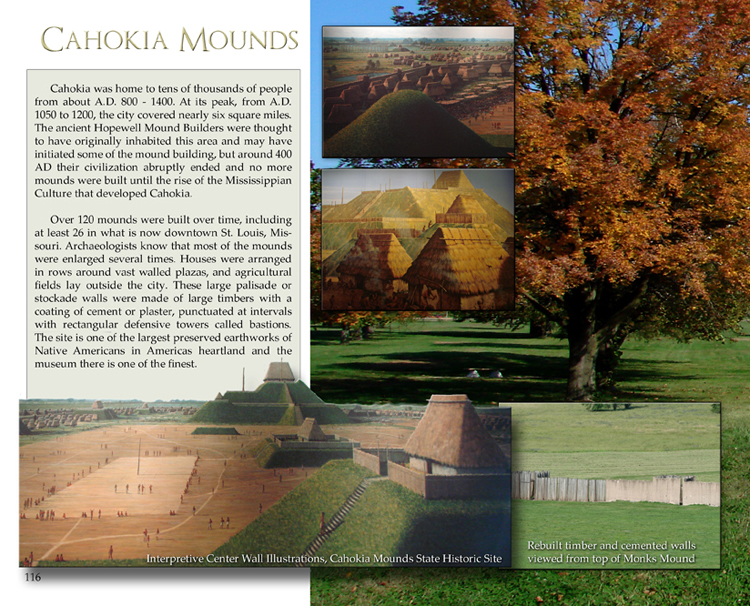
Covered with Buildings
What does it mean that the “land had become covered with buildings” in this context? The Book of Mormon text includes over 100 references to “build,” “building,” and “buildings.” Recall how Dr. Roger Kennedy, the former director of the Smithsonian’s American History Museum, explained this term. “Build and building are also very old words, often used in this text [his book] as they were when the English language was being invented, to denote earthen structures. About 1150, when the word build was first employed in English, it referred to the construction of an earthen grave. Three hundred and fifty years later, an early use of the term to build up was the description of the process by which King Priam of Troy constructed a “big town of bare earth.” So when we refer to the earthworks of the Ohio and Mississippi Valleys as buildings no one should be surprised.” Roger G. Kennedy, Hidden Cities: The Discovery and Loss of Ancient North American Civilization.
All along the Ohio and Mississippi Rivers, young Mormon would have passed by these earthworks and mounds. Most of the hundreds of thousands of sites have long since been destroyed, but many can still be visited today. Along the Ohio River, there are sites such as the one in Moundsville, West Virginia that I discussed in the Mosiah chapter. Other sites include Marietta and Portsmouth, Ohio, the Mann site near Evansville, Indiana, and several in Illinois.” Moroni’s America page 241-42
Grave Creek Mound
In the painting we show Grave Creek Mound at Moundsville, WV, which can be seen today. “Grave Creek Mound is the largest conical type of any of the mound builder structures. Construction of the mound took place in successive stages from about 250–150 B.C., as indicated by the multiple burials at different levels within the structures. In 1838, road engineers measured its height at 69 feet and its base as 295 feet. Originally a moat of about 40 feet in width and five feet in depth, with one causeway across it, encircled the mound. Inside the mound, archaeological researchers have discovered Adena Hopewell remains and ornaments, along with a small sandstone tablet.” Wikipedia Grave Creek Mound
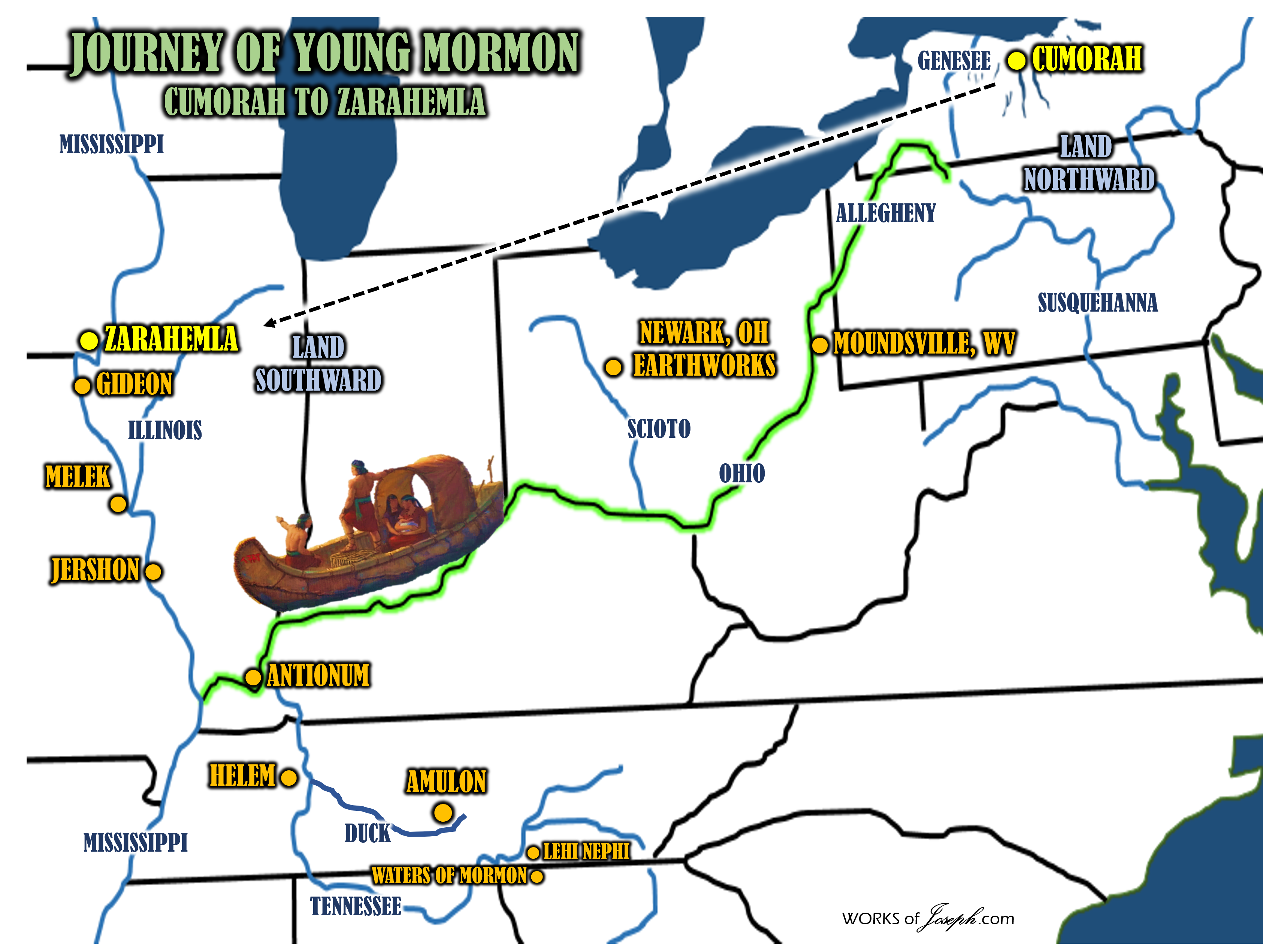 “Mormon’s father may have taken his son to visit historic sites along tributaries, such as the Scioto and Tennessee Rivers. He could have visited the ancient city of Nephi, [Waters of Mormon] the places where the sons of Mosiah taught the gospel to the Lamanites, and Alma’s land of Helam. He could have visited the battlefields described in Alma. The journey would be the perfect preparation for the future prophet and historian who would compile the history of Lehi’s descendants.” Moroni’s America page 242
“Mormon’s father may have taken his son to visit historic sites along tributaries, such as the Scioto and Tennessee Rivers. He could have visited the ancient city of Nephi, [Waters of Mormon] the places where the sons of Mosiah taught the gospel to the Lamanites, and Alma’s land of Helam. He could have visited the battlefields described in Alma. The journey would be the perfect preparation for the future prophet and historian who would compile the history of Lehi’s descendants.” Moroni’s America page 242
Title of Liberty
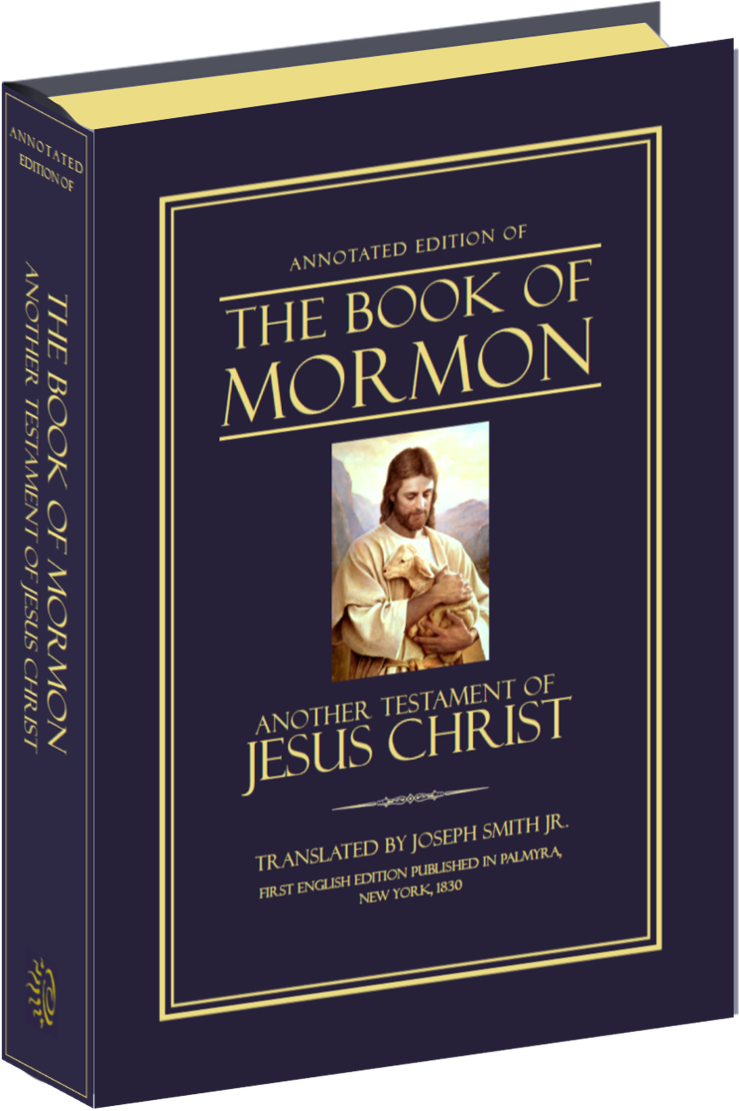 In Mormon 1:12 it speaks about peace in the land for four years. This time would have been utilized by young Mormon to read, write, and study more about these events that he was commanded to record on the plates. At the age of 16 Mormon now large in stature, was made the commander of the Nephite army. In this painting you can see the “Title of Liberty” hoisted at the top of the fort in Moundsville, as young Mormon would continue to follow this pledge of; “In memory of our God, our religion, and freedom, and our peace, our wives, and our children” Alma 46:12.
In Mormon 1:12 it speaks about peace in the land for four years. This time would have been utilized by young Mormon to read, write, and study more about these events that he was commanded to record on the plates. At the age of 16 Mormon now large in stature, was made the commander of the Nephite army. In this painting you can see the “Title of Liberty” hoisted at the top of the fort in Moundsville, as young Mormon would continue to follow this pledge of; “In memory of our God, our religion, and freedom, and our peace, our wives, and our children” Alma 46:12.
Mormon and his son Moroni were direct descendants of Manasseh (3 Nephi 5:20). Moroni would bury the plates, which Joseph Smith, a direct descendant of Ephraim, would be led to uncover. Once again the covenant of the House of Joseph and the House of Israel would be upon the Promised Land.
From the Annotated Book of Mormon by David hocking and Rod Meldrum Page 432 Order here

